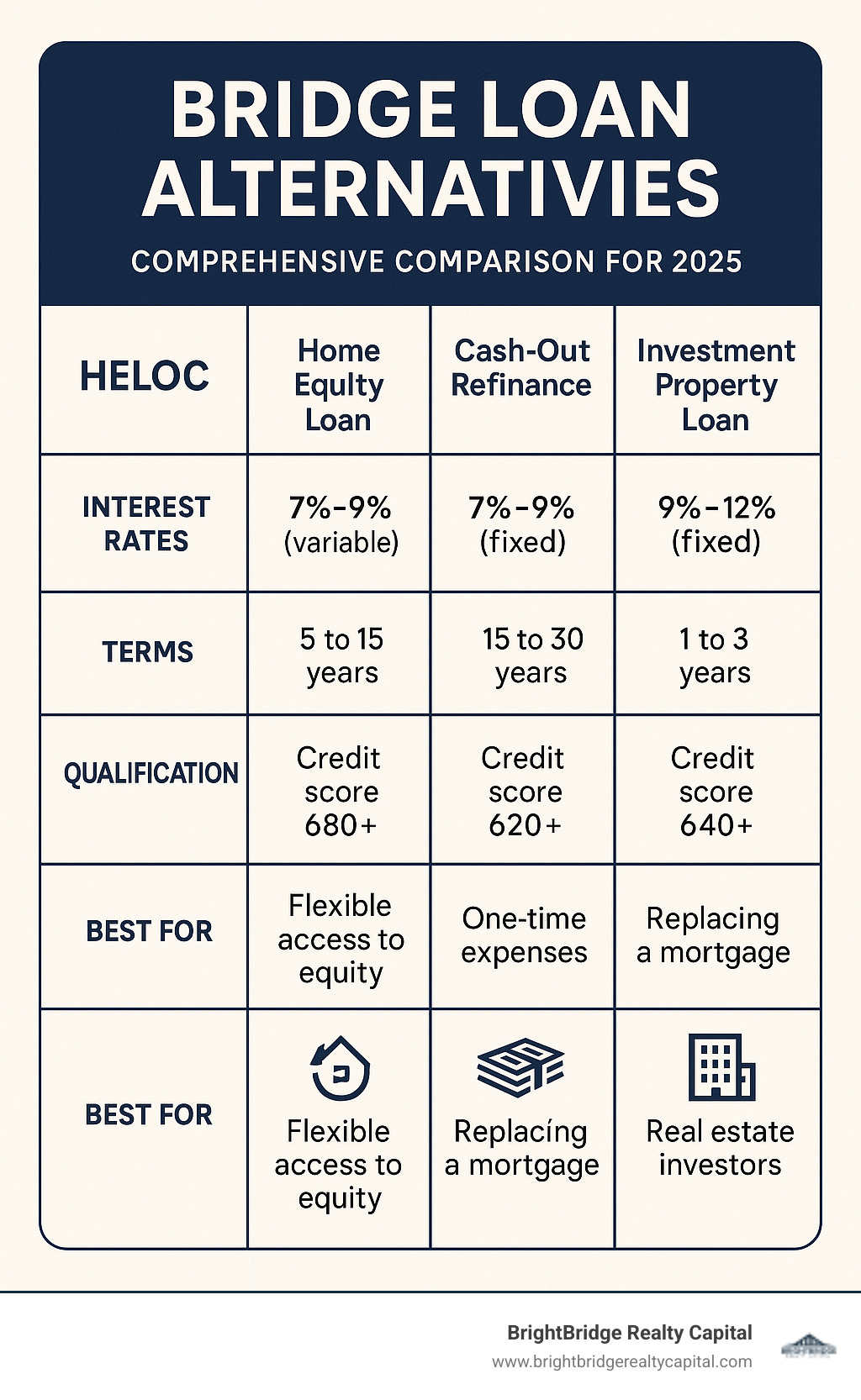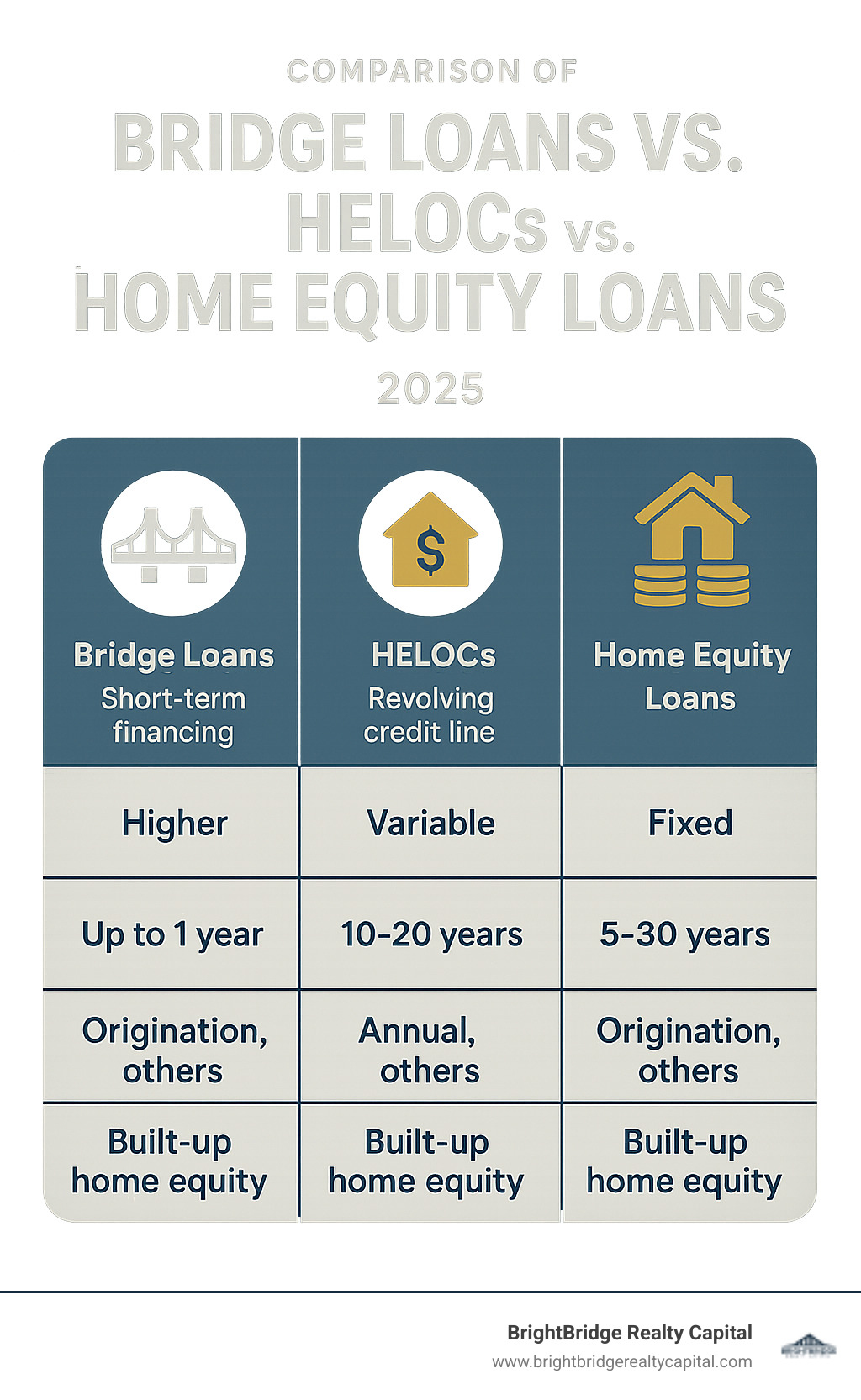Bridge Loan Alternatives: Your Path to Seamless Transitions

Why Bridge Loan Alternatives Matter for Real Estate Success
Bridge loan alternative options can save you thousands in fees and offer more flexible terms than traditional interim financing. When you're buying a new property before selling your current one, a bridge loan might seem like the only solution, but several better options often exist.
Top Bridge Loan Alternatives:
- HELOC: A revolving credit line with lower rates and longer terms.
- Home Equity Loan: A fixed-rate lump sum with predictable payments.
- Cash-Out Refinancing: Replaces your mortgage to access cash.
- Development Finance: Specialized loans for property projects.
- Personal/Business Loans: Unsecured options for smaller funding gaps.
Bridge loans have serious drawbacks, including interest rates from 0.4% to 2% per month and origination fees of 1.5% to 3%. They require high credit scores (mid-700s) and create the stress of juggling two mortgage payments on a tight 6-12 month timeline.
Fortunately, multiple alternatives exist with lower costs, longer terms, and easier qualification requirements. HELOCs may only require credit scores in the upper 600s, while home equity loans provide fixed rates for predictable budgeting. I'm Daniel Lopez, and at BrightBridge Realty Capital, I've helped countless investors find the right bridge loan alternative that matches their timeline and risk tolerance. The best solution is rarely the most obvious one; it's the one that aligns with your specific financial situation.

Bridge loan alternative terms to remember:
Understanding the Bridge Loan and Its Drawbacks
Real estate timing is rarely perfect. You find a new home before your current one has sold, or an investment opportunity requires immediate action. This is where bridge loans come in, but while they seem like a lifesaver, they often carry significant baggage.
What is a Bridge Loan and When is it Used?
A bridge loan—also known as a swing loan, interim financing, or gap financing—is short-term funding that helps you buy a new property before selling your current one. For example, if you're buying before selling in a competitive market, you need to make a strong, non-contingent offer, but your down payment is tied up in your current home. A bridge loan provides that immediate cash, secured by one of your properties.
These loans are useful when speed is critical. You might use gap financing for a down payment on a new home or for covering project costs on a fixer-upper before traditional financing is approved. Companies also use them for fast funding to seize time-sensitive opportunities. The main benefit is speed; bridge loans can fund in a few days, while traditional mortgages take 30-45 days.
The Main Disadvantages of Traditional Bridge Loans
Bridge loans are expensive and stressful. They come with higher borrowing costs, with interest rates ranging from 0.4% to 2% per month. That's a potential 24% annually, far higher than typical mortgage rates. Additionally, origination fees run 1.5% to 3% of the loan amount, plus closing costs and appraisal fees. On a $200,000 loan, fees alone could be $3,000 to $6,000.
The short repayment terms of 6-12 months, often ending in a single balloon payment, add immense pressure. This creates a risk of default if your property doesn't sell quickly. Juggling two mortgages—the new home payment plus the bridge loan—is a significant financial strain.
Furthermore, strict qualification requirements are a major hurdle. Lenders typically require a credit score in the mid-700s, substantial home equity, and a low debt-to-income ratio. These drawbacks are why savvy investors seek a bridge loan alternative that offers better terms and less financial stress.
Top Home Equity-Based Bridge Loan Alternatives

Instead of paying high bridge loan rates, you can tap into your home's equity through several smarter bridge loan alternative options that offer friendlier terms.
Home Equity Line of Credit (HELOC): A Flexible Funding Option
A HELOC is a flexible bridge loan alternative that acts like a credit card backed by your home. You're approved for a revolving credit line and can borrow, repay, and borrow again as needed. During the draw period (typically 5-10 years), you only pay interest on the amount you use. The repayment period usually spans 10-20 years, offering ample time to pay back the loan.
HELOCs often have variable interest rates, so payments can fluctuate with the market. However, their qualification requirements are more reasonable than bridge loans, typically accepting credit scores in the upper 600s with at least 15-20% home equity. The main trade-off is slower funding (2-6 weeks), but this timeline is suitable for most real estate transitions.
Home Equity Loan: A Predictable Lump-Sum Solution
For those who prefer predictability, a home equity loan is an ideal bridge loan alternative. It functions as a second mortgage, providing the full loan amount in one lump sum. With fixed interest rates and set monthly payments, budgeting becomes much easier. These loans are excellent for large, one-time expenses like a down payment and offer a longer repayment term than a bridge loan, reducing financial pressure. Qualification typically requires a credit score of 680 or higher and at least 20% home equity.
Cash-Out Refinancing and Second-Charge Mortgages
Cash-out refinancing involves replacing your existing mortgage with a new, larger one and receiving the difference in cash. This can be a brilliant bridge loan alternative, especially if you can secure a lower interest rate on your new mortgage. You can typically borrow up to 80% of your home's value, and some lenders work with credit scores as low as 580.
Second-charge mortgages are another option for accessing funds without refinancing. This separate loan sits alongside your existing mortgage, which is perfect if you have a great rate on your primary mortgage that you don't want to lose. Both options involve closing costs, but they are often more favorable than the high fees and interest associated with bridge loans.
Financing Solutions for Real estate Investors and Businesses

Real estate investors and business owners require funding that aligns with project timelines and growth opportunities. Fortunately, several specialized bridge loan alternative options are designed for these professional needs.
Development Finance and Property Refurbishment Loans
For new construction or significant renovations, traditional financing often falls short. Development finance provides short-to-medium term funding for new projects, with funds released in stages as construction milestones are met. This minimizes interest costs. Property refurbishment loans are ideal for fix-and-flip investors, covering renovation expenses until the property is sold or refinanced. At BrightBridge Realty Capital, we offer customized solutions like ground-up construction financing that provide the flexibility developers need.
Personal and Business Loans as a Bridge Loan Alternative
Personal and business loans can be excellent bridge loan alternative options for smaller funding gaps. Personal loans, whether secured or unsecured, offer fixed repayment terms (1-5 years) and can be funded quickly. Business loans from banks provide capital for working capital or expansion at lower rates than bridge loans, though they may take longer to approve.
Peer-to-peer lending platforms connect borrowers with individual investors, often with more flexible qualification processes. For businesses with outstanding invoices, invoice factoring provides immediate cash by selling accounts receivable, offering a debt-free solution.
Flexible Funding Solutions for Property Ventures
Creative financing strategies can provide the flexibility property ventures need. Crowdfunding platforms allow you to raise capital from multiple small investors, which is great for projects with strong community appeal. With seller financing, the seller acts as the lender, often resulting in more favorable terms and a faster closing.
DSCR loans (Debt Service Coverage Ratio loans) are designed for investors with strong properties but fluctuating personal income. Qualification is based on the property's cash flow, not personal income, though they typically require a down payment of 25% or more.
Modern financing models are also emerging. Some companies provide homeowners with a large portion of their home's equity upfront, taking title to the property. This removes the mortgage from your DTI ratio, making it easier to qualify for a new loan. Instead of interest, these programs charge a flat fee, eliminating the stress of managing two mortgages.
Key Factors When Choosing Your Financing Path
Choosing the right bridge loan alternative requires matching the tool to the job. Getting this right can save you thousands of dollars and significant stress.
Comparing Interest Rates, Terms, and Fees
The true cost of financing goes beyond the headline interest rate.
- Interest Rates: Bridge loans charge 0.4% to 2% per month, while alternatives like HELOCs and home equity loans offer lower rates. Consider whether a fixed or variable rate suits your risk tolerance. The Annual Percentage Rate (APR) provides the most accurate picture, as it includes fees.
- Fees: Bridge loans often have loan origination fees of 1.5% to 3%. Alternatives may have lower or no origination fees. Also, account for closing costs and potential prepayment penalties.
Always consider the long-term financial impact. A short-term, high-interest loan might solve an immediate problem but cost more over time than a lower-rate alternative with longer terms.

Understanding Qualification Requirements
Lender requirements vary significantly.
- Credit Score: Bridge loans typically require scores in the mid-700s. HELOCs may accept scores in the upper 600s, home equity loans often need 680+, and some cash-out refinances can work with scores as low as 580.
- Debt-to-Income (DTI) Ratio: This compares your monthly debt to your gross income. Most lenders want to see this below 43-50%.
- Home Equity: Most options require at least 15-20% equity in your property.
- Income Verification: While traditional loans require extensive documentation, specialized options like DSCR loans for investors focus on the property's cash flow instead of personal income, offering a valuable alternative for self-employed individuals.
How Market Conditions Influence Your Choice
Market conditions can change which bridge loan alternative is best.
- Interest Rate Environment: When rates are rising, fixed-rate options like home equity loans become more attractive than variable-rate HELOCs.
- Housing Market: In a competitive housing market, the speed of a bridge loan or fast-funded alternative can help you make a winning non-contingent offer.
- Property Sales Timeline: If homes in your area are selling slowly, the short term of a bridge loan is risky. Alternatives with longer repayment periods offer more security.
- Economic Stability: A stable economy generally means more financing options and better terms. During uncertain times, creative solutions like seller financing may become more viable.
Frequently Asked Questions about Bridge Loan Alternatives
Clients often have similar concerns when considering financing. Here are answers to the most common questions we hear.
What are the main risks associated with these alternatives?
Every bridge loan alternative has its own risks. With HELOCs, the primary concern is variable rate risk—if market rates rise, so will your payments. For home equity loans and cash-out refinancing, the main risk is over-leveraging your property; if you can't make payments, you could lose your home.
Borrowing from family or friends can strain personal relationships, so it's wise to create a formal written agreement. Some alternatives, like certain personal loans, may have higher long-term costs if not paid off quickly. Finally, any missed payment will impact your credit score, affecting future borrowing ability.
Can you provide a real-world example of using a bridge loan alternative?
Yes. A client, Sarah, found her dream apartment in a competitive market where only non-contingent offers were being considered. Her down payment was tied up in her current home's equity.
Instead of a costly bridge loan, Sarah secured a HELOC against her current home. This gave her the funds for a non-contingent offer at a much lower interest rate. She won the bid for the new apartment and had the flexibility to sell her old home at the right price without the pressure of a short-term loan deadline. Once her original home sold, she paid off the HELOC in full, saving thousands in interest and fees.
What is a modern financing model and how does it work as an alternative?
Innovative bridge loan alternative models are changing the buy-before-sell process. Instead of a loan, some companies assess your home's value and provide a large portion of its equity upfront—often around 70%—as cash. The company takes title to your property, which removes your existing mortgage from your debt-to-income ratio, making it easier to qualify for your next mortgage.
You retain control over the selling process and timeline. When the home sells, you receive the remaining proceeds minus a transparent flat fee, typically around 2.5% of the sale price. This model replaces fluctuating interest rates with a clear, upfront cost and eliminates the stress of managing two mortgages.
Finding Your Ideal Path to a Seamless Transition
Choosing the right financing can feel overwhelming. The best bridge loan alternative is not a one-size-fits-all solution; it depends entirely on your unique goals, risk tolerance, and timeline.
- Risk Tolerance: Are you comfortable with the variable rates of a HELOC, or do you prefer the predictability of a fixed-rate home equity loan?
- Timeline: If you need funds in days, a fast-funded option is critical. If you have weeks to plan, you may secure better terms with a cash-out refinance.
- Market Conditions: In a competitive market, speed is key. In a slower market, you can prioritize lower costs and better terms.
For real estate investors, partnering with a direct lender provides the speed and flexibility that traditional banks can't offer. At BrightBridge Realty Capital, we understand that investment opportunities are time-sensitive. Our reputation is built on fast closings, often within a week, because we are direct lenders who eliminate intermediary delays.
Whether you're pursuing a fix-and-flip or a ground-up development, we structure financing that aligns with your investment strategy. The best bridge loan alternative is the one that fits your specific circumstances and gives you peace of mind. Take the time to assess your financial situation and goals to choose the path that's right for you.
Ready to explore your options? Explore fix-and-flip financing options to see how we can help you find the perfect financing solution for your next investment success.


